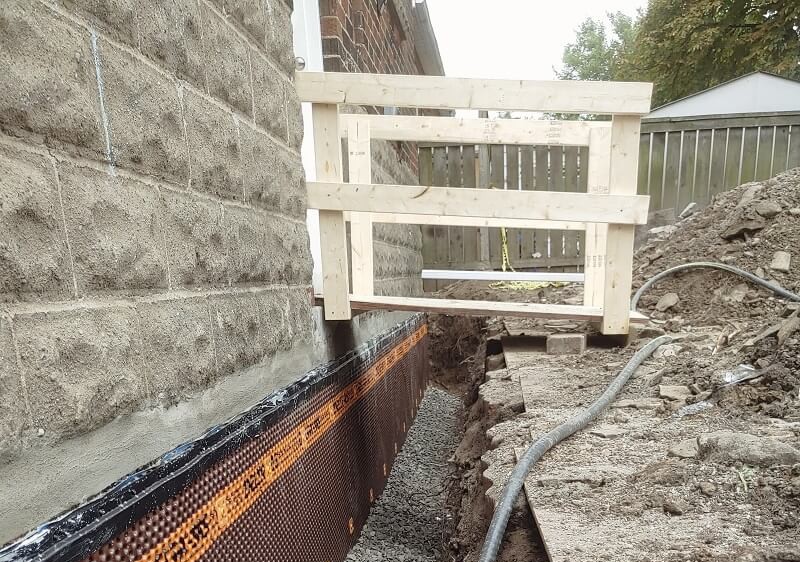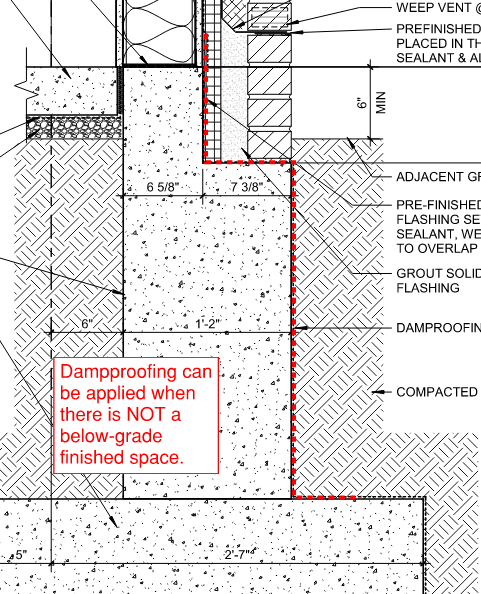Safeguard your foundation with proactive damp removal newcastle
Safeguard your foundation with proactive damp removal newcastle
Blog Article
Checking Out the Numerous Techniques and Solutions for Effective Damp Proofing
Moisture in buildings postures considerable challenges to both structural honesty and indoor air quality. Numerous techniques and remedies have arised to fight this pervasive issue. From typical damp-proof membrane layers to innovative chemical therapies, each approach supplies one-of-a-kind benefits. Comprehending these alternatives is important for efficient moisture control. Choosing the appropriate remedy depends on details structure conditions and demands, motivating further expedition into the most efficient wet proofing techniques offered.
Comprehending the Reasons of Dampness
Although wetness can occur from different resources, comprehending these reasons is important for effective removal. Typically, wetness originates from 3 key resources: climbing moist, penetrating moist, and condensation. Increasing wet happens when groundwater takes a trip up-wards via permeable products, such as brick or stone, often due to an absence of an effective barrier (damp proofing newcastle). Permeating moist is generally triggered by exterior factors, consisting of roof leaks, faulty rain gutters, or harmed wall surfaces, permitting water to penetrate a building. Condensation, on the other hand, arises from excess moisture airborne, typically exacerbated by poor ventilation and temperature distinctions, causing water beads basing on surfaces. Recognizing these underlying issues is necessary, as each kind of moisture requires a tailored technique for remediation. Proper assessment helps in identifying one of the most effective solutions, inevitably guarding the architectural integrity of a structure and improving interior air quality
Standard Damp-Proof Membranes

Chemical Damp-Proofing Solutions
Chemical damp-proofing options use an ingenious technique to avoid moisture intrusion in buildings. These techniques generally include the application of liquid chemicals that pass through masonry and create a barrier versus increasing wet. Commonly made use of chemicals include silanes, siloxanes, and various other water-repellent agents that react with surface area materials to create a hydrophobic layer.The application procedure generally calls for boring openings into the wall surfaces, infusing the chemical solution, and permitting it to treat. This technique is specifically helpful for older frameworks where traditional damp-proof membrane layers might be not practical. Chemical damp-proofing can be less disruptive and extra affordable than comprehensive renovation projects.While effective, these services depend on correct application and ecological conditions for peak efficiency. mould treatment newcastle. Regular upkeep and tracking are necessary to ensure the long life of the damp-proofing therapy. On the whole, chemical damp-proofing represents a flexible choice for safeguarding structures against moisture-related damage
Cavity Wall Surface Building Techniques
Tooth cavity wall surface construction strategies offer countless benefits, specifically in moisture control and power efficiency. By including an air space in between 2 layers of masonry, these walls efficiently alleviate water access while boosting insulation. This mix not just safeguards frameworks from wetness however also contributes to minimized power usage.
Advantages of Dental Caries Wall Surfaces
When thinking about efficient damp proofing methods, the advantages of tooth cavity walls stick out prominently. Dental caries walls include 2 different layers, creating an air gap that successfully lowers dampness penetration. This style reduces the danger of dampness, as the external wall surface serves as an obstacle against rain and water access. Additionally, tooth cavity wall surfaces enhance thermal insulation, which contributes to power performance by reducing warm loss. They additionally provide sound insulation, aiding to develop a quieter interior setting. Additionally, the air gap enables air flow, which helps in dampness control and lowers the chance of mold development. These benefits not only enhance the total comfort of a building yet also add to its longevity and architectural integrity.
Dampness Control Approaches
Effective moisture control methods are essential in dental caries wall surface building to assure lasting security versus dampness. One main technique entails the unification of weep openings, which facilitate water drain from the tooth cavity, avoiding build-up. Additionally, the usage of breathable membrane layers can help manage dampness degrees while enabling trapped vapor to run away. Correct placement of insulation is additionally crucial, as it should not block drain courses. Furthermore, ensuring that the external fallen leaves of the cavity wall are built with waterproof products boosts general toughness. Normal maintenance checks are important to determine any type of clogs or damages early, guarding the framework's honesty. Ultimately, a mix of these methods forms a robust protection against wetness breach in tooth cavity walls.
Insulation and Power Effectiveness
Insulation plays a vital function in improving power performance within dental caries wall building. By integrating shielding products, these wall surfaces develop a thermal obstacle that decreases heat loss and reduces power consumption. Effective insulation not just aids keep a steady interior temperature level but likewise alleviates the danger of dampness, as it protects against condensation within the wall tooth cavity. Various methods, such as the usage of rigid foam boards or mineral wool, can be employed to achieve perfect insulation efficiency. Additionally, correct installment is vital to assure that spaces and voids are decreased, which can or else compromise power effectiveness. Ultimately, a well-insulated dental caries wall surface contributes considerably to overall sustainability and reduces cooling and heating prices for property owners.
Outside Damp Proofing Techniques
Exterior wet proofing techniques are important for securing structures from moisture infiltration. Two reliable methods consist of the application of water resistant membrane layers and the setup of French drains pipes. These remedies help minimize water accumulation and preserve the integrity of buildings.
Waterproof Membrane Layer Application
While various approaches exist for protecting against dampness access, the application of waterproof membranes stays a highly effective external damp proofing strategy. These membrane layers are normally made from products such as polyethylene, rubber, or changed bitumen, providing a durable obstacle against water infiltration. The setup procedure includes applying the membrane layer to the external surfaces of wall surfaces or foundations, making certain total coverage to stop leakages. Correct attachment and securing at joints are vital to optimizing effectiveness. Water-proof membrane layers can be used in numerous kinds, including liquid coatings and sheet membrane layers, enabling for flexibility based upon the specific demands of the framework. This method not only shields structures from moisture yet also enhances their long life and structural integrity.
French Drainpipe Setup
One reliable method for taking care of groundwater and preventing wetness build-up around a building's foundation is the installation of a French drain. This drainage system contains a trench loaded with crushed rock and a perforated pipeline that redirects surface area water away from the foundation. Appropriate setup needs cautious planning, guaranteeing that the drainpipe inclines away from the framework to assist in perfect water flow. Furthermore, the area of the drain is essential; it needs to be positioned in areas vulnerable to merging or excess dampness. Normal maintenance, consisting of clearing particles from the crushed rock and ensuring the pipe continues to be unobstructed, is get more info important for lasting efficiency. Ultimately, a well-installed French drain can considerably minimize the threat of water-related issues in foundations and cellars.
Inside Waterproofing Approaches
Interior waterproofing strategies are important for shielding a building's interior from wetness infiltration and prospective water damage. These strategies typically involve the application of specific materials and methods developed to produce a dampness obstacle within the structure. One typical method is making use of water-proof finishings or sealers on wall surfaces and floorings, which prevent wetness from permeating surfaces.Additionally, setting up interior drainage systems, such as sump pumps, can successfully handle water build-up in basements and creep areas. Another method entails using vapor obstacles, which are set up to inhibit moisture motion from the ground into living spaces.Moreover, attending to any type of cracks or spaces in walls or foundations with ideal sealants guarantees a detailed protection against water intrusion. By implementing these indoor waterproofing methods, homeowner can considerably lower the risk of mold and mildew growth, architectural damages, and other moisture-related concerns. Appropriate execution of these techniques is crucial for long-lasting defense and building stability.
Regular Maintenance and Evaluation Practices
Normal maintenance and examination techniques are essential for ensuring the long-lasting efficiency of damp proofing solutions in any kind of structure. Regular checks make it possible for homeowner to determine very early indications of moisture intrusion, such as peeling paint, mold growth, and musty odors. These indicators can signal underlying issues that require immediate attention.Inspections ought to be performed at least yearly, concentrating on prone locations like cellars, crawl rooms, and outside wall surfaces. Throughout these analyses, building owners ought to examine sealants, water drainage systems, and ventilation to verify they function correctly.Additionally, preserving downspouts and rain gutters is vital, as clogged up systems can lead to water accumulation near the foundation. Implementing a regular maintenance schedule, together with prompt repair work, can substantially prolong the life-span of damp proofing steps and shield the structural honesty of the building. Proactive procedures inevitably contribute to the general health and safety and security of the living setting.
Often Asked Concerns
Exactly How Lengthy Does Damp Proofing Generally Last?
The duration of moist proofing performance varies, usually lasting in between 20 to 50 years. Aspects such as application quality, environmental conditions, and maintenance methods greatly influence the longevity of the wet proofing treatment.

Can I Damp Proof My Home Myself?
The individual considered the usefulness of do it yourself damp proofing. With appropriate study and the appropriate materials, it is possible. They likewise acknowledged the significance of expert assistance to guarantee lasting performance and protect against future concerns.
What Are the Indicators of Ineffective Damp Proofing?
Indications of ineffective moist proofing consist of persistent moldy smells, noticeable mold growth, peeling off paint, moist spots on walls, and timber degeneration - mould treatment newcastle. Home owners must address these problems without delay to stop further damage and wellness worries
Does Damp Proofing Affect Indoor Air Top Quality?

Just How Much Does Specialist Damp Proofing Expense?
Professional wet proofing costs vary considerably, usually ranging from $1,000 to $5,000 relying on the residential property's dimension, the level of the wet issue, and picked methods. Each circumstance calls for a tailored assessment for exact prices. Generally, dampness stems from three key sources: climbing moist, permeating damp, and condensation. When considering efficient damp proofing approaches, the benefits of dental caries wall surfaces stand out plainly. Outside damp proofing techniques are essential for shielding frameworks from moisture infiltration. While various approaches exist for stopping wetness access, the application of water-proof membrane layers remains a very efficient external moist proofing method. Indicators of ineffective moist proofing consist of persistent musty odors, visible mold and mildew growth, peeling paint, moist spots on walls, and timber decay.
Report this page